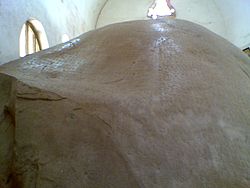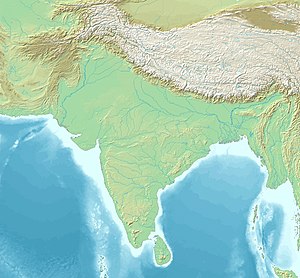Major Rock Edicts
| Major Rock Edicts of Ashoka | |
|---|---|
 Ashoka's Rock Edict at Junagadh | |
| Material | Rocks |
| Created | 3rd century BCE |
| Present location | India, Pakistan, Afghanistan |
| Part of a series on the |
| Edicts of Ashoka |
|---|
The Major Rock Edicts of Indian Emperor Ashoka refer to 14 separate major Edicts of Ashoka which are significantly detailed and represent some of the earliest dated rock inscriptions of any Indian monarch. These edicts are preceded chronologically by the Minor Rock Edicts.
History[]
Ashoka was the third monarch of the Maurya Empire in India, reigning from around 269 BCE.[1] Ashoka famously converted to Buddhism and renounced violence soon after being victorious in a gruesome Kalinga War, yet filled with deep remorse for the bloodshed of the war. Although he was a major historical figure, little definitive information was known as there were few records of his reign until the 19th century when a large number of his edicts, inscribed on rocks and pillars, were found in India, Nepal, Pakistan and Afghanistan. In India, Places where rock edicts were found are – Kalsi, Uttarakhand; Sopara, Maharashtra; Mount Girnar, Gujarat; Yerragudi, Andhra Pradesh; Dhauli, Odisha; Jaugada, Odisha. These many edicts, of which Ashoka's Major Rock Edicts were the first and most impressive, were concerned with practical instructions in running a kingdom such as the design of irrigation systems and descriptions of Ashoka's beliefs in peaceful moral behavior. They contain little personal detail about his life.[1]
Authorship[]
The Major Rock Edicts are very generally attributed to Ashoka.[2] Strictly speaking though, the inscriptions of the Major Rock Edicts, just as those of the Major Pillar Edicts, are not inscribed in the name of "Ashoka", but in the name of "Devanampriya" ("Beloved of the God", thought to be a general regnal title like "Our Lord"), "Devanampriya Priyadasi" ("Our Lord Priyadasi", or literally "Our Lord who glances amicably") or "Devanampriya Priyadasi Raja" ("Our Lord the King Priyadasi").[2] This title also appears in Greek in the Kandahar Bilingual Rock Inscription, when naming the author of the proclamation as βασιλεὺς Πιοδασσης ("King Piyodasses"), and in Aramaic in the same inscription as "our lord, king Priyadasin".[3]
The association of the Major inscriptions with "Ashoka" is only a reconstruction based on the 3rd-4th century CE Dipavamsa which associates the name "Ashoka" with the name "Priyadarsi", and an extrapolation based on the fact that the name "Ashoka" appears with the title "Devanampriya" ("Beloved of the Gods") in a few of the Minor Rock Edicts.[2] Christopher Beckwith has suggested that "Priyadarsi" was a king in his own right, probably the son of Chandragupta Maurya known to the Greeks as Amitrochates, and Ashoka was either just a Buddhist legend or a much later king who authored the Buddhist Minor Rock Edicts around the 1st century CE.[2]
Conversely, the Major Rock Edicts in the name of King Priyadasi do not have a clear Buddhist character, being mainly codes of conduct gathered under the name of "Dharma" (translated as Eusebeia ("Piety") in Greek and "Truth" in Aramaic in the Kandahar Bilingual Rock Inscription), and never mentioning Buddhism, the Buddha or the Samgha.[2]
List of Major Rock edicts[]
The major rock edits of Ashoka include:[4]
- Rock Edict I
- Prohibits animal slaughter. Bans festive gatherings and killings of animals. Only two peacocks and one deer were killed in Asoka’s kitchen. He wished to discontinue this practice of killing two peacocks and one deer as well.
- Major Rock Edict II
- Provides for care for man and animals, describes recipients as the Chola, Pandyas, Satyapura and Cheras Kingdoms of South India, and the Greek king Antiochus II and his neighbours.[5]
- Major Rock Edict III
- Generosity to Brahmans. Issued after 12 years of Asoka’s coronation. It says that the Yuktas (subordinate officers) and Pradesikas (district Heads) along with Rajukas (Rural officers) shall go to the all areas of kingdom every five years and spread the Dhamma Policy of Asoka.
- Major Rock Edict IV
- Dhammaghosa is ideal to the mankind and not the Bherighosa. Impact of Dhamma on society.
- Major Rock Edict V
- Concerns about the policy towards slaves. He mentions in this rock edict "Every Human is my child". Appointment of Dhammamahamatras is mentioned in this edict.
- Major Rock Edict VI
- Describes King’s desire to get informed about the conditions of the people constantly. Talks about welfare measures.
- Major Rock Edict VII
- Requests tolerance for all religions - "To foster one’s own sect, depreciating the others out of affection for one’s own, to exalt its merit, is to do the worst harm to one’s own sect."

- Major Rock Edict VIII
- Describes Asoka’s first Dhamma Yatra to Bodhgaya & Bodhi Tree.
- Major Rock Edict IX
- Condemns popular ceremonies. Stress in ceremonies of Dhamma.
- Major Rock Edict X
- Condemns the desire for fame and glory. Stresses on popularity of Dhamma.
- Major Rock Edict XI
- Elaborates Dhamma Major
- Rock Edict XII
- Directed and determined request for tolerance among different religious sects.
- Also written in Greek in the Kandahar Greek Edict of Ashoka (last portion)
- Major Rock Edict XIII
- It is the largest inscription from the edict. It talks about the Ashoka's victory over Kalinga and also mentions about the high number of casualties in that war.[6] King considered the victory by "Dhamma" to be the foremost victory; mentions the victory of "Dhamma" where the Greek being named Amtiyoga or Amtiyaka ( WIKI

